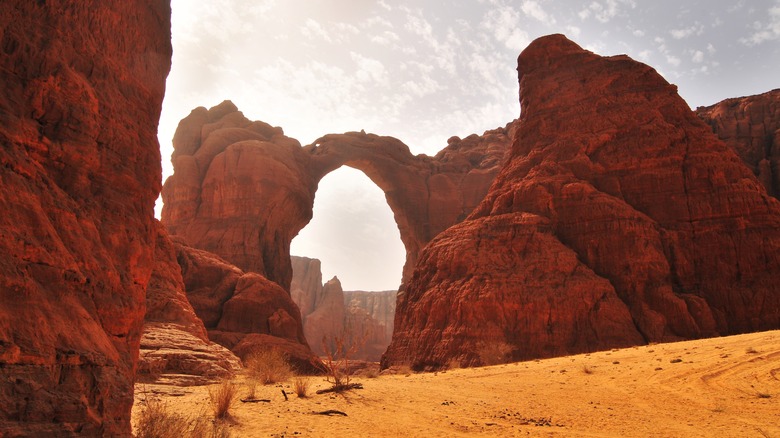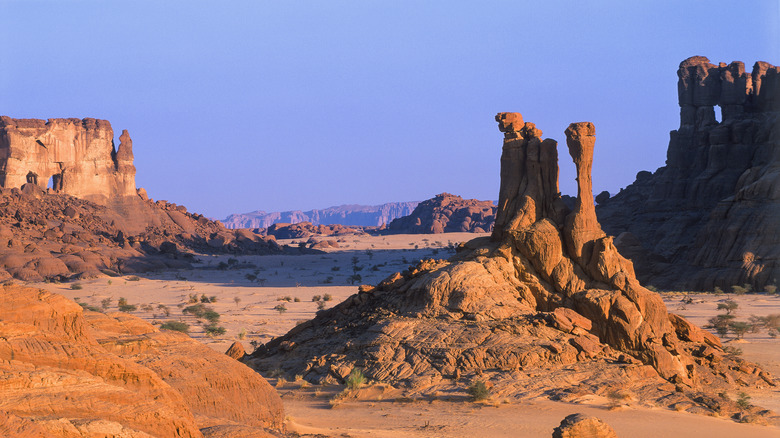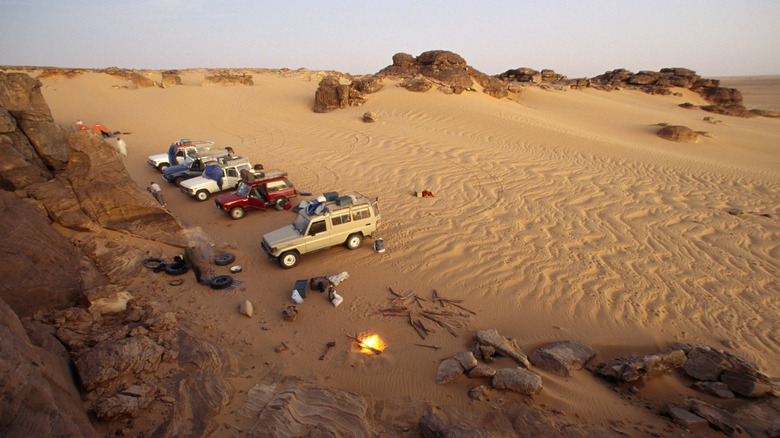Hidden In The Remote Desert Of Africa Is One Of The World's Largest Natural Arches
You have probably heard about the breathtaking rock arches of Utah's National Parks. How about Mother Nature's Fairy Bridge in China, the world's largest natural stone arch? These geological marvels all around the world seem to have captured the hearts of the many adventurers who come across them. However, little is known about the natural arches outside the U.S. or China, especially when they're located smack in the middle of the Sahara Desert. Such is the case for the Aloba Arch in the African country of Chad, a natural landmark seldom visited by travelers. According to the Natural Arch and Bridge Society (NABS), The Aloba Arch is "one of the most magnificent natural arches in the world." With an impressive length of 250 feet and a height of 400 feet, it certainly seems so. But why is this magnificent formation hardly visited by travelers?
The arch's lack of popularity is partly because the Aloba Arch is located in a pretty remote region of the desert. Reaching the arch requires a strenuous journey. Also, the basic infrastructure and underdeveloped roads in Chad make it a complicated country to visit. The Islamic Development Bank reported that in 2006, only 540 miles of the country's nearly 25,000 miles of roads were paved. But fret not: If you want to visit the Aloba Arch, you can still find ways to venture into the desert.
How the Aloba Arch was formed and its exact location
The Sahara Desert encompasses several underrated countries in Northern Africa filled with natural wonders, and Chad's Ennedi Plateau — where the Aloba Arch is located — is not the exception. Besides being rich in culture and history with many rock paintings, art, and etchings left behind by prehistoric and nomadic African cultures, the Ennedi Plateau is home to other impressive geological formations like awe-inspiring towers and pillars. The Aloba Arch takes the gold, though.
The Aloba Arch ranks eighth on the Natural Arch and Bridge Society's list of the world's 19 largest natural arches. It was formed over centuries due to the erosion of rocks and sediments, according to the NABS. The society theorizes that the arch's formation was done in two stages. First, the arch's upper part was apparently eroded from a vertical wall on a cliff's face, forming what is known as a buttress-type natural arch. Later, the soft sandstone that forms the bottom of the arch was eroded away, likely by a stream. (To give you a sense of time, the Ennedi Plateau was an ocean 350 million years ago.) This erosion eventually created the natural bridge.
Nowadays, traveling to Chad to see the Aloba Arch can certainly be tricky. The journey through the Ennedi Plateau isn't easy, and the U.S. Department of State considers Chad as a risky destination to visit due to "crime, terrorism, civil unrest, and kidnapping." To safely journey through Chad and the desert, booking an expertly guided tour is highly advised.
Reaching the remoteness of the Aloba Arch
Temperatures along the Sahara and the Ennedi Plateau are extreme. During the day, scorching heat reaching 104 degrees Fahrenheit will make traversing the terrain almost impossible with lows in the 70s. From mid-November to February, though, the temperatures are more reasonable and comfortable, peaking in the 80s and bottoming out in the 50s. But you still need to worry about getting access to Chad (for which you need a visa and vaccinations) as well as the Ennedi Plateau. A World Heritage Site and Natural and Cultural Reserve, the plateau is restrictive in terms of who is allowed to access it.
A good option for expertly (and safe) guided tours is Kumakonda, a travel agency specializing in trips around West and Central Africa. It offers several expeditions through Chad, including ethnic trips for learning about indigenous cultures as well as visits to the Ennedi Plateau's Aloba Arch and the rare West African crocodile colony in the area. The agency has good reviews on Google, with an average score of 4.5 stars. Native Eye will also bring tourists across Northern Chad and the Ennedi Plateau, but you'll need to ask when you book if they go to the arch. Native Eye has a 4.5-star rating on Responsible Travel. Or opt for Chad Travel and Tours, offering travelers a 16-day expedition (for several thousand dollars) through the Ennedi region, combining visits to natural landmarks with cultural and historical experiences.
In such a remote place on the planet, the Aloba Arch, along with the pristine wilderness and rock formations that surround it, is a natural African monument well worth visiting. This seldom-seen but absolutely glorious natural marvel is definitely a prized spot for only the most courageous and adventurous of travelers.


